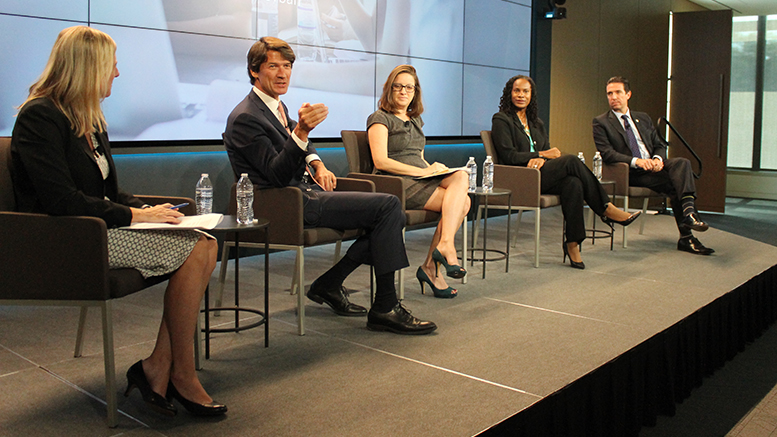Why do businesses like to team up with community colleges? Because they grasp what company partners need and respond quickly.
That’s key to creating successful partnerships with businesses, according to two panels of experts convened Thursday by the Urban Institute in Washington, D.C.
When Amazon wanted to create an apprenticeship in cloud computing, it formed a partnership with Northern Virginia Community College (known as NOVA) because the college “had a clear understanding of market demands and a willingness to move fast,” said Shanika Hope, head of content and research at AWS Educate, Amazon Web Services.
It usually takes 18 to 24 months to create an academic program at a community college, Hope said. “We wanted this in six weeks, and they said yes.”
Since the partnership started in 2017, NOVA has trained 200 apprentices, said Steven Partridge, vice president for strategic partnerships and workforce innovation at NOVA. The apprentices are paid while they take part in the six-week program. Amazon also pays for their training. After one year, the apprentices become full-time employees.
That front-loaded approach is changing the mindset of companies, who generally wait until people earn a degree before hiring them, Partridge said.
Due to the success of its cloud computer partnership with Amazon, NOVA is starting conversations to expand its relationship as the company develops its new headquarters (HQ2) nearby.
NOVA assigned an administrator to be the point of contact for that project, Partridge said. Although the college hopes to form more apprenticeship programs with Amazon, “it’s not just about Amazon; it’s about filling the skills gap” in a region with 60,000 to 70,000 middle-skills jobs available.
Know employers’ needs
The number-one thing community colleges can do to develop strong partnerships is to “meet employers physically where they are,” said Molly Scott, principal research associate at the Urban Institute. Beyond that, Scott suggested inviting business representatives to events and have “get-to-know-you conversations that set you up for a more intense relationship.”
When developing a workforce partnership, Kenneth Adams, dean for workforce and economic development at Bronx Community College (BCC) in New York City, said the key question is: “What’s the problem the employer has that we can solve?”
For example, a company may be struggling to adhere to certain government regulations, he said. A community college partner could help identify the problem and develop solutions.
Evolving programs
Sometimes a program a college already offers can evolve into one that helps local industry needs. In a community with a high rate of opioid overdose deaths, BCC took the lead in training students – many of them formerly incarcerated drug addicts – to become “recovery peers” with an option to earn up to nine credits for a public health degree.
When local healthcare providers determined that the use of a recovery peer is reimbursable, “we saw an opening and created a training program,” Adams said. To make that partnership work, the college had to take the lead in providing extensive support to the participating students.
In another instance, K-12 leaders were having a hard time getting students interested in technology careers, so BCC launched a partnership involving 120 middle and high schools to train people in career awareness.
Buy-in is critical
The Foundation for California Community Colleges has taken on the administrative and human resources burden for employers, including paying for workers’ compensation, and “that opened up a lot of businesses and industry to provide paid work experiences,” said Haden Springer, the foundation’s workforce development manager.
In North Carolina, colleges set up their apprenticeship programs, but the state system uses federal funds to support regional coordinators who facilitate partnerships in rural areas, said Anne Bacon, director of strategic planning and policy at the North Carolina Community College System.
Rick Bouillon, associate vice president for workforce and economic development at Salt Lake Community College (SLCC) in Utah, said companies need to understand there is cost in taking some of their best leaders “offline” to work with students in the classroom or oversee students doing on-the-job training.
SLCC is partnering with the Stadler railcar manufacturing company, the local K-12 system and an economic development agency on a two-year apprenticeship program that includes dual credits. By the time students complete the program, they have an associate degree and a job at Stadler with full benefits.
While buy-in from college leaders is important for a successful partnership, it is also critical to get buy-in from faculty, Hope said.
Government has a role in supporting partnerships, too, Adams said. For example, the student aid system needs reforms so low-income students can receive some support while working as unpaid interns, taking part in work-study programs, and taking non-credit courses to earn short-term credentials.
Low-income students also need help to cover the cost of certificate and licensing fees. Adams also added that people shouldn’t lose eligibility for food stamps or other federal benefits if they take a paid internship.
Boosting completion
When students realize they will have a job when they complete a program, that motivates them to enroll and persist – and that enables the college to show its impact, Hope said.
Partridge believes partnerships like NOVA’s arrangement with Amazon will lead to higher completion rates. Many high school students know they want to go to college, but they don’t know what they want to do. Having a connection with an employer lets students know they have a pathway to a job.
“Our students have very little career capital,” said Adams, noting that many of them haven’t had discussions about higher education or career planning at home or with a mentor.
“Employment opportunities can create career capital,” he said, which can help students develop a thoughtful plan, get exposure to the workplace and inspire them to complete.

